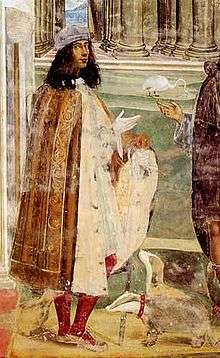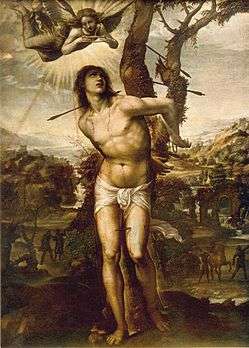Il Sodoma
| Il Sodoma | |
|---|---|
 Self-portrait with badgers in a fresco at Monte Olivetto | |
| Born |
Giovanni Antonio Bazzi 1477 Vercelli, Piedmont |
| Died |
February 14, 1549 Siena |
| Nationality | Italian |
| Education | Martino Spanzotti, Gerolamo Giovenone |
| Movement | High Renaissance Sienese School |
| Patron(s) | Agostino Chigi, Pope Julius II, Pope Leo X |
Il Sodoma (1477 – February 14, 1549) was the name given to the Italian Renaissance painter Giovanni Antonio Bazzi.[1] Il Sodoma painted in a manner that superimposed the High Renaissance style of early 16th-century Rome onto the traditions of the provincial Sienese school; he spent the bulk of his professional life in Siena, with two periods in Rome.
Biography
Giovanni Bazzi was of the family de Bazis, and born at Vercelli in Piedmont in 1477. His first master was the "archaic" Martino Spanzotti;[2] he also appears to have been a student of the painter Giovenone. After acquiring the strong coloring and other distinctive stylistic features of the Lombard school and— though he is not known to have travelled to Milan—[3] somehow absorbing the superficial mannerisms of Leonardo (Freedberg 1993:117), he traveled to Siena before 1503, perhaps at the behest of agents of the Spannocchi family, and began with fresco cycles for Olivetan monks and a series of small Ovidian ceiling panels and a frieze depicting the career of Julius Caesar for Sigismondo Chigi at Palazzo Chigi.[4]
Along with Pinturicchio, Sodoma was one of the first to practice in Siena the style of the High Renaissance. His first important works were seventeen frescoes in the Benedictine monastery of Monte Oliveto Maggiore, on the road from Siena to Rome, illustrating the life of St Benedict in continuation of the series that Luca Signorelli had begun in 1498. Gaining fluency in the prevailing popular style of Pinturicchio, Sodoma completed the set in 1502 and included a self-portrait with badgers.[5]
Sodoma was invited to Rome in 1508 by the celebrated Sienese merchant Agostino Chigi and was employed there by Pope Julius II in the Stanza della Segnatura in the Vatican. He executed two great compositions and various ornaments and grotesques in vaulted ceilings divided in feigned compartments in the antique manner that Pinturicchio had recently revived, working at the same time as Raphael. Vasari's rhetorical story that Sodoma's larger works did not satisfy the pope, who engaged Raphael to substitute a program of Justice, Poetry, and Theology is not borne out by the documents.[6]
Before October 1510 he was in Siena, where he painted the exterior of Palazzo Chigi in monochrome chiaroscuro with scenes from the Bible and from Antiquity, the first such work seen in Siena (Bartalini 2001:553). His painting at this time began to show distinct Florentine influences,[7] especially of Fra Bartolommeo. His exterior frescoed stucco

Called again to Rome by Chigi, in the Villa Chigi (now the Villa Farnesina), working alongside Baldassarre Peruzzi, Sodoma painted subjects from the life of Alexander the Great: Alexander in the Tent of Darius and the Nuptials of the Conqueror with Roxanne, which some people consider his masterpiece. When Leo X became pope (1513), Sodoma presented him with a picture of the Death of Lucretia (or of Cleopatra, according to some accounts). Leo gave him a large sum of money as a reward and created him a cavaliere.
Sodoma returned to Siena and, at a later date, sought work in Pisa, Volterra, and Lucca. From Lucca he returned to Siena not long before his death on 14 February 1549 (older narratives say 1554). He had supposedly squandered his property and is said, without documentary support, to have died in penury in the great hospital of Siena. One of his pupils was Giomo del Sodoma.
In his youth, Sodoma had married, but he and his wife soon separated. A daughter married Bartolomeo Neroni, called also Riccio Sanese or Maestro Riccio, one of Sodoma's principal pupils. Instead, he was considered by contemporaries to have been homosexual, and was known from 1512 on as "Il Sodoma" (or "the Sodomite"). Giorgio Vasari, in particular, stressed this aspect. Perhaps it was a nickname that resulted from a joke; but Bazzi seems to have used the name with pride.[8]
Work


Some critics see in Sodoma's Madonna in the Pinacoteca di Brera (if it really is by him) the direct influence of this master. Modern criticism tends not to follow Morelli in supposing that Raphael painted Sodoma's portrait next to himself in The School of Athens,[9] while a drawing at Christ Church is supposed to be a portrait of Raphael by Sodoma.
Among his masterpieces are the frescoes, completed in 1526, in the chapel of St. Catherine of Siena painted for the church of San Domenico (Siena), depicting the saint in ecstasy, fainting as she receives the Eucharist from an angel. In the Oratory of San Bernardino, are scenes from the history of the Virgin, painted in conjunction with Pacchia and Beccafumi (1536–1538). These frescoes depict the Visitation and the Assumption. In San Francesco are the Deposition from the Cross (1513) and Christ Scourged. Many critics regard one or the other of these paintings as Sodoma's masterpiece. In the choir of the Pisa Cathedral is the Sacrifice of Abraham, and in the Uffizi Gallery of Florence a St. Sebastian.
Some of his works, including the Holy Family now in the Pinacoteca, Siena have been mistaken for works of Leonardo da Vinci. His easel pictures are rare; there are two in the National Gallery, London.
Partial list of works
- Flagellation of Christ (1510) - Museum of Fine Arts, Budapest
- The Road to Calvary (1510) - Museum of Fine Arts, Budapest
- Cinuzzi Deposition (before 1513) - Pinacoteca, Siena
- The Death of Lucretia (1513) - Museum of Fine Arts, Budapest
- Saint George and Dragon (1518) - National Gallery of Art, Washington, D.C.
- Rape of the Sabine Women (1525) - Galleria Nazionale d'Arte Antica, Rome
- St. Sebastian (1525) - Oil on canvas, 206 x 154 cm Galleria degli Uffizi, Florence
- Three Fates (1525) -Galleria Nazionale d'Arte Antica Rome
- Adoration of the Magi (c. 1530) - Sant'Agostino, Siena[10]
- Ordination of Saint Alfonso (1530) - Santo Spirito, Siena
- Crying for dead Christ or Pietà (1533) - Museo Soumaya, Mexico City
- Saint Jerome in Penitence (c.1535-1545) - National Gallery, London
- The Mystical Marriage of Saint Catherine (1539–1540) - Galleria Nazionale d'Arte Antica, Rome
- Pietà (1540) - Galleria Borghese, Rome
- Sacra Conversazione (1542) - Museo Nazionale di San Matteo, Pisa
- Saint Sebastian with Madonna and Angels (1542) - Museo Nazionale di San Matteo, Pisa
- Allegory of Celestial Love, Chigi-Saracini Collection, Siena
- Leda Galleria Borghese, Roma
- Santa Maddalena (Collezione privata)
- The Marriage of Alexander and Roxanne - Fresco, Villa Farnesina, Rome
- Pietà (Collezione privata)
Critical assessments
It is said that Sodoma jeered at Giorgio Vasari's Lives of the Artists and that Vasari repaid him by presenting a negative account of Sodoma's morals and demeanour and withholding praise of his work. According to Vasari, the name by which Bazzi was known was "Il Mattaccio" (the Madcap, the Maniac), this epithet having been bestowed upon him by the monks of Monte Oliveto. He dressed gaudily, like a mountebank, and his house was a Noah's ark, owing to the strange miscellany of animals he kept there. He was a cracker of jokes, fond of music, and he sang poems composed by himself on indecorous subjects.
Vasari alleges that Sodoma was always a negligent artist, his early success in Siena, where he painted many portraits, being partly due to lack of competition, a judgment in which Sidney Freedberg concurs. Vasari asserts that as he aged, he became too "lazy" to make cartoons for his frescoes but daubed them straight onto the wall. Vasari nevertheless admits that Sodoma produced some works of very fine quality and that during his lifetime his reputation was high.
Notes
- ↑ Also wrongly spelled Razzi. The artist's real surname is uncertain. He is said to have borne the family name of "Sodona" but also the name "Tizzioni". Sodona is the signature on some of his pictures. While Bazzi was corrupted into Razzi, Sodona may have been corrupted into "Sodoma".
- ↑ A minor painter, called "archaic" by Freedberg 1993:117, of whom one signed picture is known.
- ↑ Morelli, in his Italian Pictures in German Galleries claimed that he ripened into an artist only during two years (1498-1500) that he spent with Leonardo in Milan.
- ↑ Bartalini, Roberto (September 2001). "Sodoma, the Chigi and the Vatican Stanze". The Burlington Magazine. Vol. 143 no. 1182. pp. 544–553. Zambrano, Patrizia (September 1994). "A New Scene by Sodoma from the Ceiling of Palazzo Chigi at Casato di Sotto, Siena". The Burlington Magazine. Vol. 136 no. 1098. pp. 609–612.. Sigismondo was the guarantor of Sodoma's performance for Julius, October 1508, and his brother Agostino became Sodoma's notable patron.
- ↑ "il sodoma". Flickr - Photo Sharing!.
- ↑ Recent cleaning revealed the essential intergrity of Sodoma's existing ceilings, illustrated by Bartalini 2001.
- ↑ Freedberg (1993:117) notes the source of his Crucifixion (Pinacoteca, Siena) in the composition of an altar for Santissima Annunziata, Florence, begun by Filippino Lippi and finished by Perugino.
- ↑ "Il Sodoma". Encyclopedia Britannica.
- ↑ The face looks too old, apart from anything else; Perugino or Timoteo Viti are considered more likely models
- ↑ A dispute concerning the painting and a tondo now in the Walters Art Museum, Baltimore, was resolved in 1536; Wolfgang Loseries, "Sodoma's 'Holy Family' in Baltimore: The 'Lost' Arduini tondo" The Burlington Magazine 136 No. 1092 (March 1994), pp. 168-170 notes a miniature dated 1532 that adapts Sodoma's composition.
References
- Cust, Robert H. Hobart (1906). Giovanni Antonio Bazzi. London: John Murray.
- Hayum, A. (1976). Giovanni Antonio Bazzi 'Il Sodoma'. New York: New York University.
- Carli, Enzo (1950). Sodoma.
- Marciano-Agostinelli Tozzi, Maria Teresa (1951). Sodoma. Messina: Tipografia ditta d'Amico.
- Freedberg, Sidney J. (1993). Painting in Italy 1500-1600. Penguin Books. pp. 117–119 et passim.
- Radini Tedeschi, Daniele (2008). Sodoma.
- Radini Tedeschi, Daniele (2010). Sodoma , la vita le opere e gli allievi di uno dei massimi artisti del Rinascimento.
External links
 Media related to Sodoma at Wikimedia Commons
Media related to Sodoma at Wikimedia Commons- Artist/Painter: Sodoma
- Leonardo da Vinci: anatomical drawings from the Royal Library, Windsor Castle, exhibition catalog fully online as PDF from The Metropolitan Museum of Art, which contains material on Il Sodoma (see index)